
Mammillaria vetula (syn. subsp. gracilis) ‘Arizona Snowcap’ on 7-8-18, #473-13.
Thimble Cactus
Mammillaria vetula subsp. gracilis
‘Arizona Snowcap’
mam-mil-AR-ee-uh VET-uh-luh GRASS-il-is
Syn. of:
Mammillaria vetula
Commonly sold as:
Mammillaria gracilis var. fragilis
mam-mil-AR-ee-uh GRASS-il-is FRAJ-ih-liss
Other synonyms of Mammillaria vetula from Plats of the World Online (24) (Updated on 12-8-23 from Plants of the World Online): Cactus gracilis (Pfeiff.) Kuntze, Cactus pulchellus (Salm-Dyck) Kuntze, Cactus regius (C.Ehrenb.) Kuntze, Cactus vetulus (Mart.) Kuntze, Chilita fragilis (Salm-Dyck ex K.Brandegee) Orcutt, Chilita vetula (Mart.) Orcutt, Escobariopsis gracilis (Pfeiff.) Doweld, Escobariopsis vetula (Mart.) Doweld, Krainzia gracilis (Pfeiff.) Doweld, Mammillaria fragilis Salm-Dyck ex K.Brandegee, Mammillaria gracilis Pfeiff., Mammillaria gracilis var. fragilis A.Berger, Mammillaria gracilis var. pulchella (Salm-Dyck) Salm-Dyck, Mammillaria gracilis f. pulchella (Salm-Dyck) Schelle, Mammillaria grandiflora Salm-Dyck, Mammillaria kuentziana P.Fearn & B.Fearn, Mammillaria magneticola J.Meyrán, Mammillaria pulchella Salm-Dyck, Mammillaria regia C.Ehrenb., Mammillaria vetula subsp. gracilis (Pfeiff.) D.R.Hunt, Mammillaria vetula subsp. lacostei Plein & Heinr.Weber, Mammillaria vetula subsp. magneticola (J.Meyrán) U.Guzmán, Neomammillaria fragilis (Salm-Dyck ex K.Brandegee) Britton & Rose, Neomammillaria vetula (Mart.) Britton & Rose
***Although there are differences, Plants of the World Online by Kew lists Mammillaria vetula subsp. gracilis as a synonym of Mammillaria vetula. According to descriptions, Mammillaria vetula has 1-2 central spines and 25 radial spines where Mammillaria vetula subsp. gracilis has NO central spines. My plants have no central spines.
Mammillaria vetula Mart. is the accepted scientific name for this species of Mammillaria. It was named and described as such by Carl (Karl) Friedrich Philipp von Martius in Nova Acta Physico in 1832.
Mammillaria vetula subsp. gracilis (Pfeiff.) D.R.Hunt is now considered a synonym of Mammillaria vetula. This subspecies was named and described as such by David Richard Hunt in Mammillaria Postscripts in 1997. It was first named Mammillaria gracilis Pfeiff. by Ludwig Karl Georg Pfeiffer in Gartenzeitung in 1838.
Mammillaria gracilis var. fragilis A.Berger was named and described by Alwin Berger in Kakteen in 1929. This name is what the industry is commonly using…
The genus, Mammillaria Haw., was named and described by Adrian Hardy Haworth in Synopsis Plantarum Succulentarum in 1812.
As of 12-8-23 when this page was last updated, Plants of the World Online by Kew lists 138 accepted species in the Mammillaria genus. It is a member of the plant family Cactaceae with 150 genera. That number is likely to change as updates are made on POWO.
THERE ARE SEVERAL LINKS AND GROWING RECOMMENDATIONS AT THE BOTTOM OF THE PAGE FOR FURTHER READING.

Mammillaria vetula (syn. subsp. gracilis) ‘Arizona Snowcap’ on 7-8-18, #473-14.
I brought this cactus home from Lowe’s on July 8, 2018. The label said it is a Mammillaria gracilis fragilis monstrose. I thought it was especially neat because it was so white.
The label says:
“Mammillaria gracilis v. fragilis monstrose is a special monstrose cultivar of the charming miniature Mammillaria gracilis fragilis. Clusters prolifically to form mats. Satiny creamy yellow flowers in the late winter. Protect from frost to prevent scarring. Provide bright light; hardy to 20F; to 4” tall. Water thoroughly when soil is dry.
The sides of the 11 oz. (3 1/2″ tall x 3 1/2″ diameter) pot was bulging. The cluster of plants measured 2″ tall x 5″ wide and was hanging over the sides of the pot.

Mammillaria vetula (syn. subsp. gracilis) ‘Arizona Snowcap’ on 7-8-18, #473-15.
I had to do a little research about this plant before I published information about it and I found out it was likely the cultivar ‘Arizona Snowcap’. The cultivar was created “in captivity” and it may even be a hybrid. The species, Mammillaria vetula and subspecies Mammillaria vetula subsp. gracilis are native to the states of Hidalgo, Guanajuato, and Querétaro in Mexico where they are found in pine forests at high altitudes.

Mammillaria vetula (syn. subsp. gracilis) ‘Arizona Snowcap’ on 7-8-18, #473-16.
Mammillaria vetula and the subspecies are small, freely clustering plants that can grow 4-5″ tall x about 1 1/2″ in diameter… Not sure how long that takes because none of mine ever grew that big. Supposedly, the offsets of the species are not as bad about falling off as the subspecies.
Their tubercles are round and bluntly conical and the areoles have a small tuft of wool. The axils between the tubercles on the subspecies and cultivar are bare while the species may be slightly wooly and bristly (hairs).
The areoles on top of the tubercles of the species produce 25 or so (up to 50 on mature specimens) white radial spines while the subspecies have 11-16. The radial spines on the ‘Arizona Snowcap’ are shorter, thicker, and very dense. The species generally have 1-2 reddish-brown central spines that are longer than the radials. The subspecies and cultivar “usually” have no central spines.

Mammillaria vetula (syn. subsp. gracilis) ‘Arizona Snowcap’ on 7-8-18, #473-17.
Llifle (Encyclopedia of Living Forms) says “Mammillaria ‘Arizona Snowcap’ is a monstrous form of Mammillaria vetula subsp. gracilis which is characterized by densely packed separate clusters of spines. It looks so different from the wild species that it isn’t easy to realize that they are related. This cultivar offsets generously from the sides and upper part of the plant, which gives it a snowball appearance. A mature group can reach 10-12 cm in diameter and 6-8 (10) cm in height.”

Mammillaria vetula (syn. subsp. gracilis) ‘Arizona Snowcap’ on 7-29-18, #487-70
I put the cluster of plants in a larger pot so it could have more room…

Mammillaria vetula (subsp. gracilis) ‘Arizona Snowcap’ on 8-18-18, #498-5.
Mammillaria vetula subsp. gracilis ‘Arizona Snowcap’ look their best if grown in full sun, so I put it on the back deck with most of the other cactus.

Mammillaria vetula (syn. subsp. gracilis) on 8-26-18, #499-28.
They did very well over the summer in full sun and I didn’t notice any sunburn.

Mammillaria vetula (syn. subsp. gracilis) ‘Arizona Snowcap’ at 1 5/8″ tall x 5 1/8″ wide on 10-10-18, #519-54.
I had to move the potted plants inside for the winter on October 10 (2018) because the forecast was calling for an “F” in a few days and the nighttime temperatures were getting cooler. I usually measure the cactus and succulents when I bring them inside. This cluster of plants measured 1 5/8″ tall x 5 1/2″ wide.
It is recommended that they watered sparingly during the summer and barely it at all during the winter months. I usually go over my cactus and succulents at the same time as my other potted plants, but I go over them quickly.
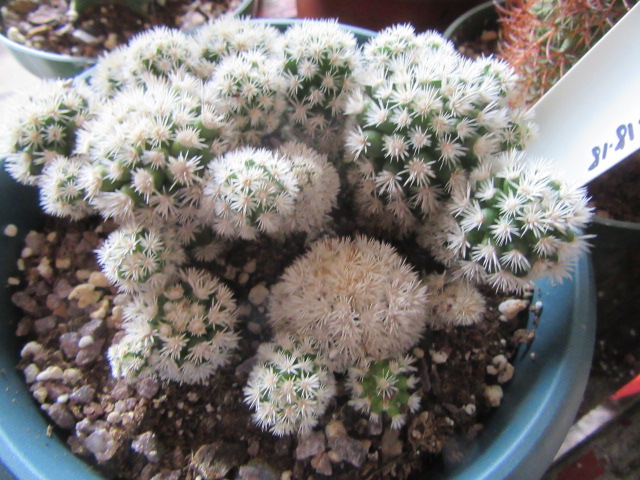
Mammillaria vetula (syn. subsp. gracilis) ‘Arizona Snowcap’ on 11-29-18, #534-28.
November 29 was a nice spring-like day, so I took the cactus to the back porch for a photoshoot. I was working on a post to show the difference between the cactus in my collection.
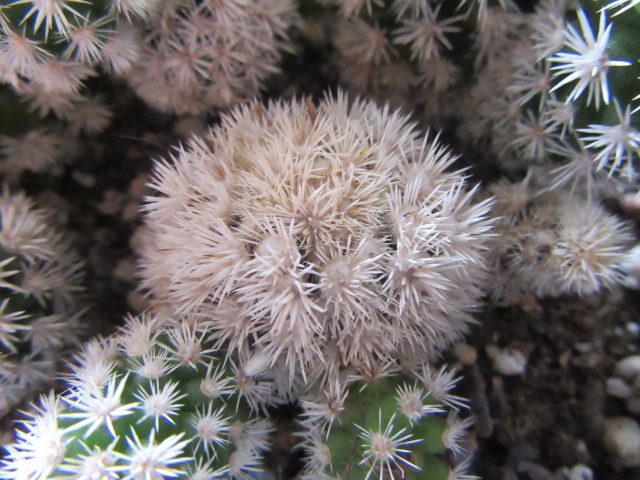
Mammillaria vetula (syn. subsp. gracilis) ‘Arizona Snowcap’ on 11-29-18, #534-29.
I had a Mammillaria vetula subsp. gracilis before that was much different. When I first brought this plant home none of the offsets were as thickly covered as a few are now but I still knew it was different than the previous one. In fact, there was one next to it at Lowe’s when I found this one like I had before. Strange only a few offsets spines are thicker and the others aren’t. It is going to be an interesting plant to watch.
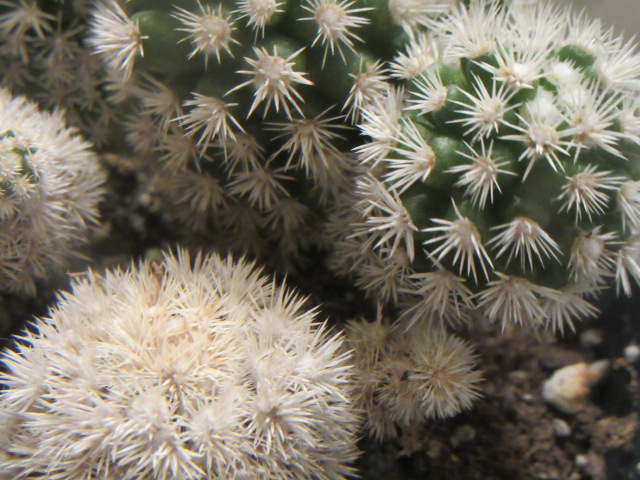
Mammillaria vetula (syn subsp. gracilis) ‘Arizona Snowcap’ close-up on 12-1-18, #535-21.
The species, Mammillaria vetula, has 1-2 central spines and at least 25 radial spines. The subspecies often lack the central spines and only have 11-16 radial spines. The plant I had before also had much longer spines. Its flowers are also shorter. I noticed the areoles on the top have a small tuft of wool but not so much on the lower parts.
<<<<2019>>>>

Mammillaria vetula (syn. subsp. gracilis) ‘Arizona Snowcap’ on 5-25-19, 576-53.
Once evening temperatures warmed up I moved the potted plants back outside for the summer. I moved the cactus to the back porch where they could receive full sun. Unfortunately, many offsets died over the winter, including the more white ones. Maybe the monstrous mutation makes them more “fragilis”.
I was fairly busy during the summer so I didn’t take many photos. All the plants did very well despite a little neglect.

Mammillaria vetula (syn. subsp. gracilis) ‘Arizona Snowcap’ on 10-11-19, #639-74.
I had to bring the potted plants inside on October 11 because an “F” was in the forecast. I always take photos of the plants as I bring them inside and measure the cactus and some of the succulents. Several of the “whiter” offsets had died and one had a bud…

Mammillaria vetula (syn. subsp. gracilis) ‘Arizona Snowcap’ on 10-13-19, #641-3.
Then another…

Mammillaria vetula (syn. subsp. gracilis) ‘Arizona Snowcap’ on 11-2-19, #646-7.
November 2 was a nice spring-like day so I took several cactus that were flowering to the front porch for a photoshoot.

Mammillaria vetula (syn. subsp. gracilis) ‘Arizona Snowcap’ on 11-16-19, #651-2.
On the 16th I decided it was high time I worked on the Mammillaria vetula subsp. gracilis ‘Arizona Snowcap’. I had already re-potted several other cactus and succulents. Some just needed their soil changed while others needed bigger pots. I used about 50/50 Miracle Grow Potting Soil and pumice for the mix. There are many recipes online for cacti and succulents, but I prefer something simple. I had used a mixture of 2 parts potting soil with 1 part chicken grit and 1 part perlite for many years then read where succulent enthusiasts prefer pumice. SO, I have been trying that since the fall of 2018 with favorable results. I re-pot any time of the year as necessary, but I have found Fall is a great time. After a summer of regular watering, the potting mixture can become kind of hard when it is decreased. Repotting in the Fall gives the plants nice and loose soil for the winter.
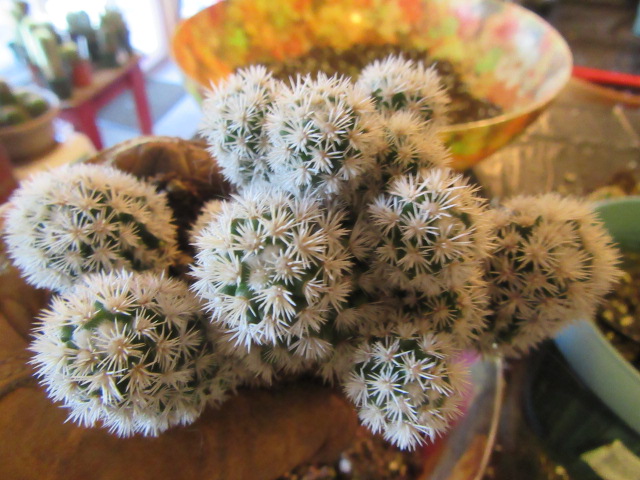
Mammillaria vetula (syn. subsp. gracilis) ‘Arizona Snowcap’ on 11-16-19, #651-3.
The largest cluster seemed to be pretty well intact.
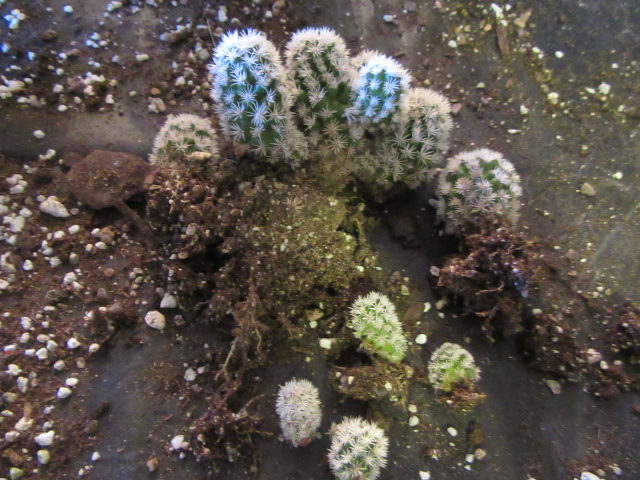
Mammillaria vetula (syn. subsp. gracilis) ‘Arizona Snowcap’ on 11-16-19, #651-4.
After removing the clump from the pot I had to remove the dead…
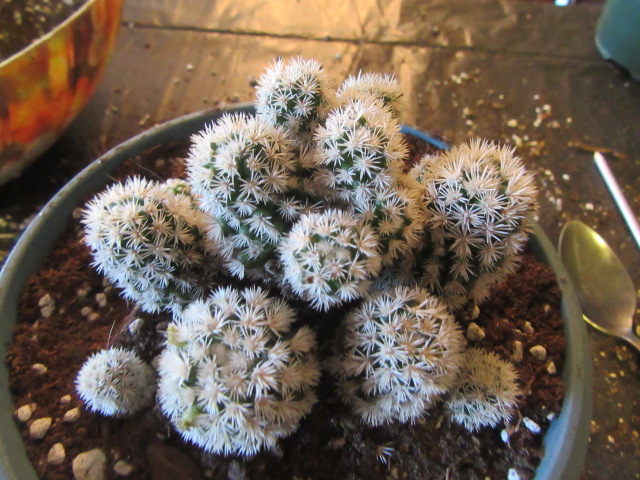
Mammillaria vetula (syn. subsp. gracilis) ‘Arizona Snowcap’ repotted on 11-16-19, #651-5.
Then I kind of centered the live plants around the larger cluster.

Dead Mammillaria vetula (syn. subsp. gracilis) ‘Arizona Snowcap’ on 11-16-19, #651-6.
This is part of the dead plants. I had discarded a few earlier in the summer. Hopefully, the rest will do OK over the winter.
<<<<2020>>>>

Mammillaria vetula (syn. subsp. gracilis) ‘Arizona Snowcap’ at 1 1/2″ tall on 10-15-20, #747-80.
I had to bring the potted plants inside for the winter on October 15 (2020) because an “F” was in the forecast. As always, I took photographs and measurements. The Mammillaria ‘Arizona Snowcap’ did very well over the summer and FINALLY, some of the plants in the cluster are more white. The tallest plant in the group measured 1 1/2″ tall on October 15.

Mammillaria vetula (syn. subsp. gracilis) ‘Arizona Snowcap’ on 10-15-20, #747-81.
As you can see in the above photo, some of the plant’s spines seem thicker. I was waiting for this… One of the largest plants in the group has a circle of buds. 🙂

Mammillaria vetula (syn. subsp. gracilis) ‘Arizona Snowcap’ on 11-6-20, #755-5.
LOOKING GOOD on November 6. Interesting how such a small plant can have a circle of flowers.
<<<<2021>>>>
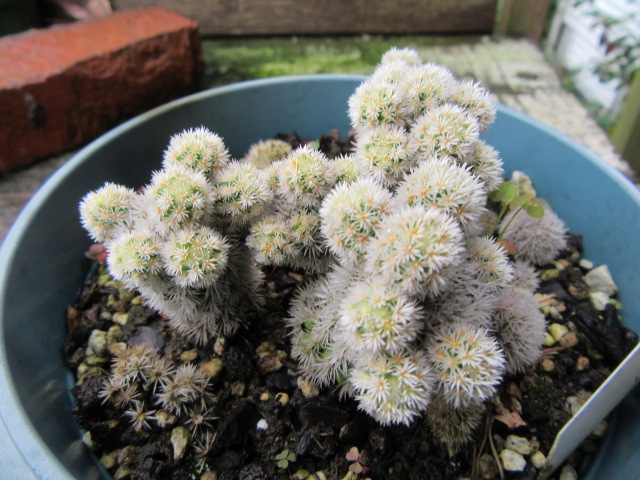
Mammillaria vetula (syn. subsp. gracilis) ‘Arizona Snowcap’ at 2 1/4″ tall on 10-28-21, #853-24.
I didn’t have to move the potted plants inside for the winter until October 28 in 2021. There wasn’t a chance of “F” in the forecast until then which was quite unusual. The Mammillaria vetula (syn. subsp. gracilis) ‘Arizona Snowcap’ did well over the summer of 2021 and the largest plant in the cluster grew to 2 1/4″ tall…
<<<<2022>>>>
Unfortunately, this cactus didn’t make it over the summer. Now I have to try to find another one to replace it.
USEFUL INFORMATION:
Family: Cactaceae
Origin: Nursery origin. Species from Mexico
Zones: USDA Zones 10a-11 (30 to 40° F)
Size: Hmmm…
Light: Sun to part shade. Looks best when in full sun but needs to be introduced gradually.
Soil: Very well-draining soil. Potting soil with additional perlite and grit or pumice.
Water: Water sparingly during the summer and barely in the winter.
You can read my Cactus Talk & Update and Cactus & Succulent Tips to get my opinion about growing cacti and succulents.
When you bring your new plants home from the store, you need to check their roots and the soil to see if they are wet. If so, you may want to re-pot it right away. It is advisable to re-pot them in a better potting soil more suitable for cacti and succulents.
There isn’t much online about this cultivar yet, but maybe someday there will be more.
I hope you enjoyed this page and maybe found it useful. I would like to hear from you if you have any comments, questions, or suggestions. Please click on “like” if you visited this page. It helps us bloggers stay motivated. 🙂 You can check out the links below for further reading. The links take you directly to the genus and species of this plant.
Hi,
I have had an Arizona Snowcap for a number of years now & really enjoyed reading your description of them.
I live in Perth, Western Australia & find the cacti so fascinating.
I thought a lot of posts you made were some time ago & when I realised this was more recent thought would reach out.
Cheers
LikeLike
Hello Kaye! Great to hear from you. I enjoy growing many species of cacti. If I run across one I don’t have I usually bring one home. I have been writing posts for several years, but all the plant pages are updated on a regular basis. If I still have the plants, new photos are added when I take them during the summer. Merry Christmas! Take care and thanks for the comment!
LikeLike
How often do you water your arizona snowcap in autumn?
I read I should water it every week in summer- isnt it too much?
LikeLiked by 1 person
Hello Joanna! I keep my ‘Arizona Snowcap’ outside during the summer so they get rain. If it turns dry and we have no rain, then they get watered maybe once a week (or less). Once the forecast calls for an “F” in October, I bring the plants inside for the winter. Normally, I don’t water them after that all winter is over. I may water them a little in April if they are still inside. Now, when you water the cactus in the summer, you still don’t want to give them a good soaking. They don’t need a deep pot either, just enough for their roots. Excessive soil soaking up water can cause their roots to rot. That’s why you should not water them too much at a time. Let them completely dry out between watering. Don’t hesitate to contact me if you have any further questions. I hope this helps! Take care and thanks for the comment!
LikeLike
Thanks! The Arizona snowcap is tiny and cute, but its impossible to notice mealybugs behind the white spikes. I don’t know how can you deal with it 🙂
LikeLiked by 1 person
I never had many mealybugs until last winter. I have found Garden Safe Fungicide 3 works pretty well and is OMRI certified. You can use a cotton swab dipped in alcohol to remove them as well. I “don’t think” I have any issues with mealybugs on my ‘Arizona Snowcap’ but, like you said, they would be hard to notice. I have had to continually remove mealybugs on several cacti because they just keep coming back. Repeated spraying keeps them in check with some cactus because removing or touching the mealybugs with a cotton swab is difficult (due to the amount of spines). I have lost a few plants over the winter. One Aloe I had for MANY years. Some plants are more susceptible than others. I believe my issue began when an online retailer offered to send me plants if I mentioned his business… I am pretty sure where it all started because one of his plants was the first to be infested and the first to die last winter. Live and learn… OH, I used to get the Garden Safe Fungicide 3 from Lowe’s. Last year I found a bottle at Dollar General, but I bought the last one from Ebay because Lowe’s didn’t have any available.
LikeLike
I had to remove two of my Arizona’s yeasterday because it was literally eaten by meallybugs during the winter. Now I have offsets and waiting until they develop roots.
Thanks for advice 🙂
LikeLiked by 1 person
GEEZ! With some cactus, you can remove them from the pot and completely wash them off under a faucet or with a sprayer, roots and all, then put them in new potting soil. That would be very difficult with the ‘Arizona Snowcap’ and other thimble-type cactus. You can do that with other succulents like Aloe, (ETC.) as well. That could be a consideration for spring since plants that are dormant may not like it at this point. There are Neem products that work as a spray, but I have found not all plants like it. I ran out of Garden Safe one time so I bought a similar product from the local hardware store. It killed the plant I was using it on.
My mother used to raise a lot of African Violets and she used this insect repellant similar to Hot Shot No Pest Strip to repel mealy bugs. The Hot Shot may work, but you aren’t supposed to use it where people spend more than 4 hours a day in (like garages, storage building, etc.). I don’t know about you, but I am not a fan or products with warning labels like it has. A lot of my plants are on a shelf in my bedroom…
LikeLike
Indeed, I will have to use something dedicated to mealybugs but prefer not so toxic.
LikeLiked by 1 person
I agree. That’s why I prefer the Garden Safe Fungicide 3. OMRI approved (Organic Materials Review Institute).
LikeLike
Is beige color of the wool on the areola a symptom of disease in this species of cactus? I noticed that only the dead plants you threw out had brown tufts.
LikeLiked by 1 person
They start turning brown when they are dying… I don’t think it is a sign of disease.
LikeLike
I knew it! When I made the complaint to the online store, they informed me that the beige color of the areola was the ‘natural’ color of the Mammillaria Arizona Snowcap. They sold me a dying plant with mealybugs. We as a clients must be aware of beige areolas.
LikeLiked by 1 person
GEEZ! How could beige color be natural for a plant that is named ‘Arizona Snowcap’? I checked just now and I can’t even see its areolas. 🙂
LikeLike